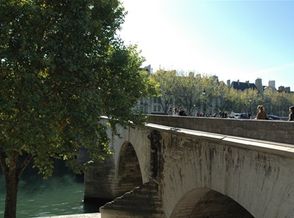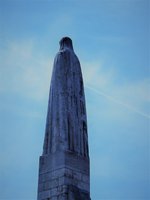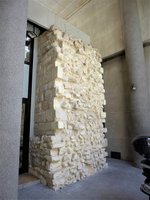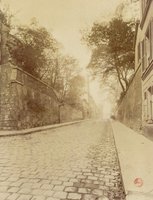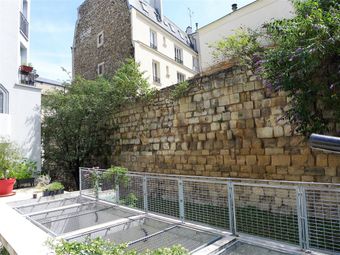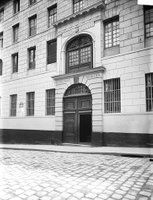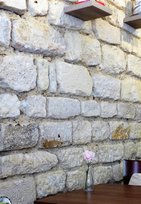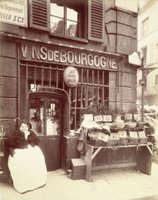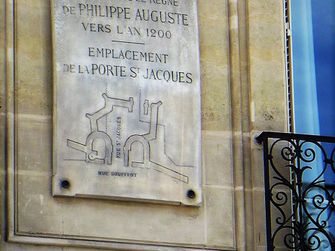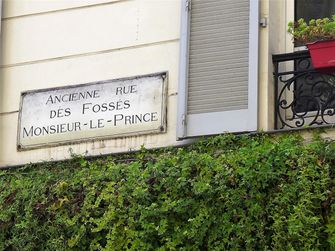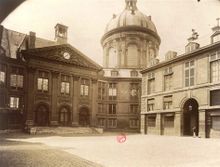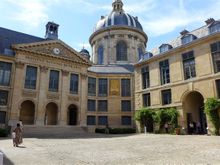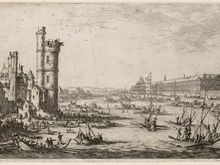Hora fugit - Un peu de Paris
Wall of Philip II - Left Bank
Ile Saint-Louis
From the Quai des Célestins, let's go to the Pont Marie. For a long time, I thought as a kid that the name of this bridge, close to Notre-Dame de Paris was simply that of the mother of Jesus; a thought getting a wrong confirmation by the high statue a little bit further on the Pont de la Tournelle. How a kid could know that Marie was the architect of the Ile Saint-Louis, remained inhabited until the early 17th century. First, the engineer Marie proceeded with the merge of the two islets separated by a channel used in the past to draw the iron chains between the two riverbanks. Then, the quays were built, starting with the Quai d'Anjou.
Here, we just cross the Ile Saint-Louis, quite worth an other stroll.
The rue des deux-ponts leads us now to Tournelle bridge. The statue of Sainte-Geneviève, patron saint of Paris, is represented high and straight under a long cape. Paul Landowski, mostly known for sculpting the Christ in Rio de Janeiro, was not happy about the result. He wanted her positioned facing Notre-Dame. I like where she is, a strong protector of her city, facing the east, from where came the barbarian Huns.
We now take the rue du Cardinal Lemoine, following the orientation of the wall.
Rue du Cardinal Lemoine
At the level of the rue des Ecoles, stood the fortified gate Saint-Victor close to the Monastery of Saint-Victor, founded in 1113. The large site of the former abbey, located outside of the walls, is now occupied by the University of Jussieu and the Arab World Institute.
Let's stay on rue du Cardinal Lemoine until we reach rue André Lartigue on the right, where two large sections of the wall can be seen. One at the library (Bibliothèque des Littératures Policières) and the other behind the fire station.
Rue Clovis
Rue Clovis and wall of Philip II
Atget – October 1899
(BnF)
Let's go back to rue Cardinal Lemoine to stop rue Clovis. The wall seen from the street appears to be a little higher than it was in reality. This is due to the wall being rebuilt underneath when the rue Clovis was built. You can enter in the courtyard of building at 7, rue Clovis to see a long portion of the wall.
The natural slope of the hill was considerably reduced when the Rue Clovis was built. You can get an idea of this by looking at the facade of the former Scots College at 65, rue Cardinal Lemoine. On the first floor, the window above the entrance porch was in fact the former entrance door!
Scots Collège
65, rue du Cardinal Lemoine
Atget - 1900
(Médiathèque Architecture et Patrimoine)
68, rue du Cardinal Lemoine
I suggest you take a break at the cosy Ninon place. On top of a selection of delicious pastries and savoury treats you will get a nice view of a well restored portion of the wall.
Rue Thouin - Rue de l'Estrapade - Rue des Fossés Saint-Jacques
Now let’s turn right onto rue Thouin. When you have passed n° 14, turn around and have a look at the very narrow building; Its shape is due to the wall, the remains of which are still visible in the courtyard.
Arrived at Place Emmanuel Levinas, continue along Rue de l'Estrapade, which runs parallel to the outer line of the wall. After the rue d'Ulm, we arrive at the peaceful Place de l'Estrapade. Far to be delightful in the past … it was the scene of strappado, a horrific form of torture.
Let’s continue along the rue des Fossés Saint-Jacques, which name evokes the ditch outside the wall of Philip Augustus. At the end of the street, where stands the restaurant au Port Salut, we will notice the old inscription of the street engraved in the stone.
Au Port Salut – Cabaret rue des Fossés St Jacques
Atget – 1903
(Musée Carnavalet)
Rue Saint-Jacques - Rue Monsieur-le-Prince
Let's turn right onto rue Saint-Jacques, where at no. 172, a plaque shows where the fortified gate Saint-Jacques stood in the wall of Philip Augustus. This place is now where rue Saint-Jacques and rue Soufflot intersect.
We continue on Rue Monsieur-le-Prince, built along the former defensive ditch of the wall.
Cour du Commerce Saint-André - Rue Mazarine
Let's cross the boulevard Saint-Germain to enter the courtyard of the Commerce Saint-André. An imposing Philippe Auguste tower can be seen inside the restaurant at no. 4. Maybe you can have a glimpse of it through the window.
Let's follow the passage towards the rue Saint-André des Arts. Let's take the lively rue de Buci on the left and then the rue Mazarine. In the past when the car park was public, it was possible to see the imposing remains of the wall on both levels. In the charming passage Dauphine, there is also a remnant of the tower inside the medical school.
Quai de Conti - Institut
Let's take the rue Guénégaud on the right, and turn left onto quai de Conti where stood the fortified Nesle tower, replaced by Mazarine library built at its place.
The Tour de Nesle, a location of bloody orgies as perpetuated by legends, was destroyed in 1663 to be replaced by the Institute of France, initially a College wished for by Cardinal Mazarin. This engraving from Jacques Callot shows the Nesles Tower ruin in 1630 before its demolition, standing in front of the Louvre.
Cour de l'Institut
Quai de Conti
Atget – 1903
(Musée Carnavalet)
Texte / Photos : Martine Combes
Contact / newsletter:
